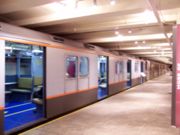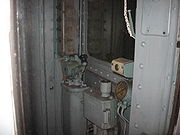
R7A (New York City Subway car)
Encyclopedia

New York City Subway
The New York City Subway is a rapid transit system owned by the City of New York and leased to the New York City Transit Authority, a subsidiary agency of the Metropolitan Transportation Authority and also known as MTA New York City Transit...
car was built in 1938 by two separate orders from different manufacturers, American Car & Foundry, and Pullman Standard. 100 R7A cars were built. Most if not all of these cars were transferred to the BMT Eastern Division in 1968-69 and served there until 1976-77.
Preservation
Car 1575 has been preserved by the New York Transit MuseumNew York Transit Museum
The New York Transit Museum is a museum which displays historical artifacts of the New York City Subway, bus, commuter rail, and bridge and tunnel systems; it is located in a decommissioned Court Street subway station in the Brooklyn Heights neighborhood of New York City...
and restored. During its service life, it was rebuilt from its original appearance by ACF
American Car and Foundry Company
American Car and Foundry is a manufacturer of railroad rolling stock. One of its subsidiaries was once a manufacturer of motor coaches and trolley coaches under the brand names of ACF and ACF-Brill. Today ACF is known as ACF Industries LLC and is based in St. Charles, Missouri...
in 1947 after an accident. It became the prototype for the R10
R10 (New York City Subway car)
The R10 is a New York City Subway car class built by the American Car and Foundry Company in 1948-1949. The cars were nicknamed Thunderbirds.-Service History:*First Date of Revenue Service: November 20, 1948, on the ' route....
, designed to test new interior and cosmetic features. While it cosmetically resembles an R10, mechanically and electrically it is still an R7A and can only operate with other prewar IND R1-9
Arnines
Arnines is a casual term used to refer to 1,703 similar New York City Subway cars built between 1930-1940 for the Independent Subway System. The name comes from the literal spelling out of the final contract under which these 1,703 cars were ordered - contract "R-9"...
cars.

R-7A specifications
- Car Builder: American Car and FoundryAmerican Car and Foundry CompanyAmerican Car and Foundry is a manufacturer of railroad rolling stock. One of its subsidiaries was once a manufacturer of motor coaches and trolley coaches under the brand names of ACF and ACF-Brill. Today ACF is known as ACF Industries LLC and is based in St. Charles, Missouri...
, Pullman StandardPullman CompanyThe Pullman Palace Car Company, founded by George Pullman, manufactured railroad cars in the mid-to-late 19th century through the early decades of the 20th century, during the boom of railroads in the United States. Pullman developed the sleeping car which carried his name into the 1980s... - Car Body: Riveted Steel
- Unit Numbers: 1550-1649 (motorized single units)
- Fleet: 100 cars
- Car Length: 60 feet, 21⁄2 inches (18.35 m)
- Car Width: 10 feet (3.05 m)
- Car Height: 12 feet, 15⁄8 inches (3.70 m)
- Total Weight: ~84653 lb (38,398 kg), #1575: 82340 lb (37,348.8 kg)
- Track Gauge: 4 feet, 81⁄2 inches (1435 mm)
- Propulsion System:
- Motors: Westinghouse 570-D5 or General Electric 714-D1, 714-D2
- Motor Power: 190 hp.
- Braking System: WABCOWestinghouse Air Brake CompanyThe railway air brake was invented by George Westinghouse of New York state in 1869. Soon after, he moved to Pittsburgh, Pennsylvania, where he established the Westinghouse Air Brake Company on September 28, 1869...
Schedule AMUE with UE-5 universal valve, ME-23 brake stand, and simplex clasp brake rigging - Air Compressor: WABCOWestinghouse Air Brake CompanyThe railway air brake was invented by George Westinghouse of New York state in 1869. Soon after, he moved to Pittsburgh, Pennsylvania, where he established the Westinghouse Air Brake Company on September 28, 1869...
D-3-F - Coupler Type: WABCOWestinghouse Air Brake CompanyThe railway air brake was invented by George Westinghouse of New York state in 1869. Soon after, he moved to Pittsburgh, Pennsylvania, where he established the Westinghouse Air Brake Company on September 28, 1869...
H2A - Total Seating: 56 seats
- Cab arrangement: Half-width operator's cab at each end; conductor controls on exterior

